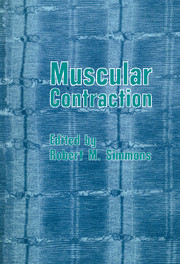Book contents
- Frontmatter
- Contents
- Dedication
- Contributors
- Preface
- 1 A. F. Huxley: an essay on his personality and his work on nerve physiology
- 2 A. F. Huxley's research on muscle
- 3 Ultraslow, slow, intermediate, and fast inactivation of human sodium channels
- 4 The structure of the triad: local stimulation experiments then and now
- 5 The calcium-induced calcium release mechanism in skeletal muscle and its modification by drugs
- 6 Hypodynamic tension changes in the frog heart
- 7 Regulation of contractile proteins in heart muscle
- 8 Differential activation of myofibrils during fatigue in twitch skeletal muscle fibres of the frog
- 9 High-speed digital imaging microscopy of isolated muscle cells
- 10 Inotropic mechanism of myocardium
- 11 Regulation of muscle contraction: dual role of calcium and cross-bridges.
- 12 Fibre types in Xenopus muscle and their functional properties.
- 13 An electron microscopist's role in experiments on isolated muscle fibres.
- 14 Structural changes accompanying mechanical events in muscle contraction.
- 15 Mechano-chemistry of negatively strained cross-bridges in skeletal muscle.
- 16 Force response in steady lengthening of active single muscle fibres.
- References
- Index
15 - Mechano-chemistry of negatively strained cross-bridges in skeletal muscle.
Published online by Cambridge University Press: 07 September 2010
- Frontmatter
- Contents
- Dedication
- Contributors
- Preface
- 1 A. F. Huxley: an essay on his personality and his work on nerve physiology
- 2 A. F. Huxley's research on muscle
- 3 Ultraslow, slow, intermediate, and fast inactivation of human sodium channels
- 4 The structure of the triad: local stimulation experiments then and now
- 5 The calcium-induced calcium release mechanism in skeletal muscle and its modification by drugs
- 6 Hypodynamic tension changes in the frog heart
- 7 Regulation of contractile proteins in heart muscle
- 8 Differential activation of myofibrils during fatigue in twitch skeletal muscle fibres of the frog
- 9 High-speed digital imaging microscopy of isolated muscle cells
- 10 Inotropic mechanism of myocardium
- 11 Regulation of muscle contraction: dual role of calcium and cross-bridges.
- 12 Fibre types in Xenopus muscle and their functional properties.
- 13 An electron microscopist's role in experiments on isolated muscle fibres.
- 14 Structural changes accompanying mechanical events in muscle contraction.
- 15 Mechano-chemistry of negatively strained cross-bridges in skeletal muscle.
- 16 Force response in steady lengthening of active single muscle fibres.
- References
- Index
Summary
Introduction
This volume to honour Andrew Huxley presents an opportunity to review a line of investigation that was strongly influenced by his ideas and experiments. In fact, Andrew Huxley's leadership in studies of muscle contraction has been exceptional all the way from the recognition of the ionic nature of membrane events, through the inception of the sliding-filament theory and the proposition of cyclic cross-bridge interactions, to the consideration of mechanical constraints on enzymatic rate constants. I was a postdoctoral fellow in Physiology at University College, London, when Andrew Huxley was there. Although I was working with Bob Simmons during that fellowship, I was helped enormously by many conversations and interactions with Andrew Huxley. The experiments I summarise here followed from ideas he first expressed.
One of Huxley's earliest publications in the muscle field (A. F. Huxley, 1957a) was a brilliant paper reviewing studies on the contraction mechanism and presenting a novel hypothesis and quantitative model. In 1957, the idea of sliding filaments was new, and the nature of the interaction between thick and thin filaments was obscure. Based on the linear fall of tetanic tension as striation spacing is increased (Ramsey & Street, 1940; A. F. Huxley & Niedergerke, 1954), and the biophysical properties of actomyosin threads, such as the increase of extensibility on addition of ATP (Weber, 1955), Huxley proposed that projections on the thick filaments undergo a cyclic interaction with the thin filament to transduce chemical to mechanical energy. In the mathematical description, specific assumptions were made for the rates of attachment and detachment of bridges between the thick and thin filaments and the dependence of those rates on the cross-bridge mechanical strain.
- Type
- Chapter
- Information
- Muscular Contraction , pp. 219 - 236Publisher: Cambridge University PressPrint publication year: 1992



